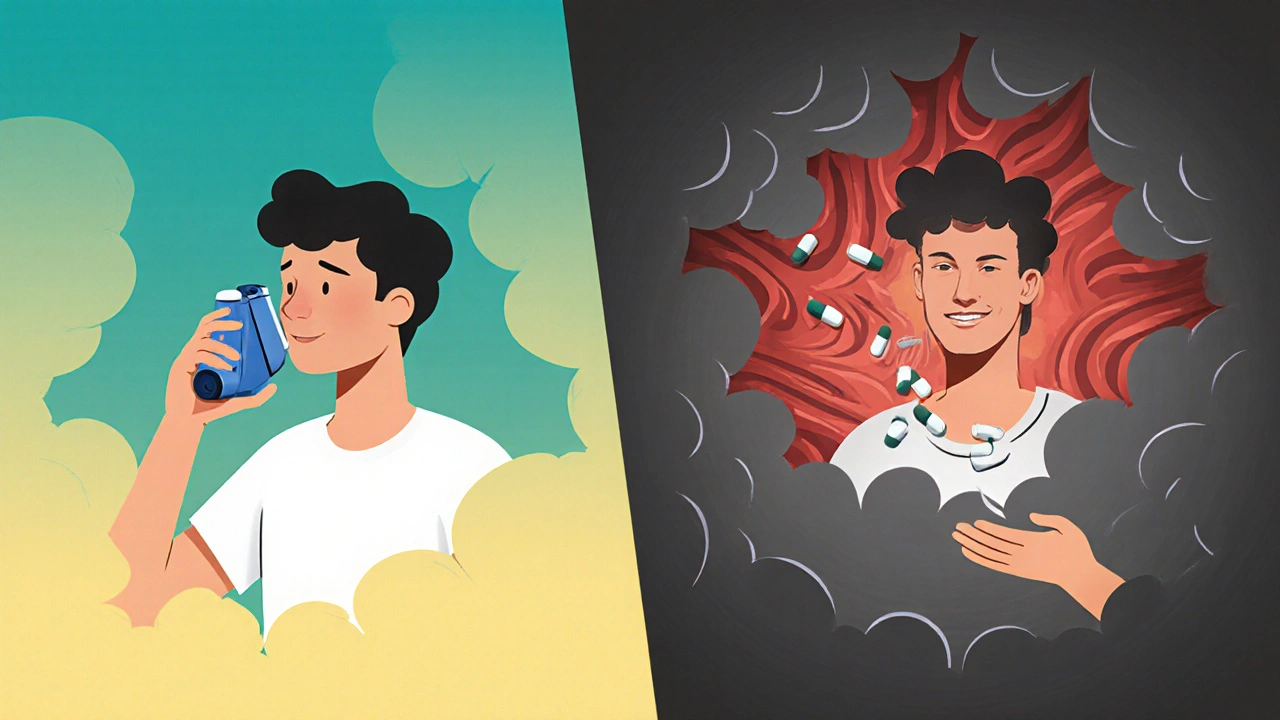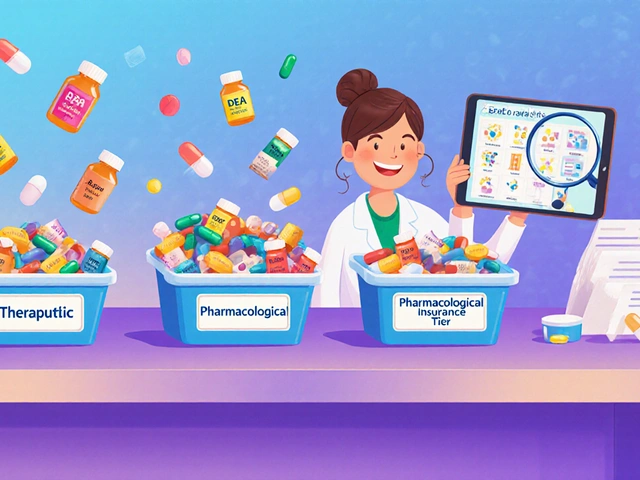When your lungs feel tight, your breath gets shallow, and coughing won’t quit, it’s not just a cold-it could be asthma. This isn’t rare. Around 300 million people worldwide live with it, and in the UK alone, about 5.4 million people are diagnosed. But here’s the thing: asthma isn’t one condition. It’s a group of conditions with different causes, triggers, and treatments. Knowing the difference between an inhaler and an oral pill isn’t just useful-it can save your life.
What Kind of Asthma Do You Have?
Asthma doesn’t look the same in everyone. The way it shows up depends on what’s triggering it and how your body reacts. The American Lung Association breaks it down into seven main types, and some experts add even more.Allergic asthma is the most common. It flares up when you breathe in pollen, dust mites, or pet dander. If your symptoms get worse in spring or around your cat, this is likely you.
Exercise-induced asthma hits during or right after physical activity. You might feel fine walking, but running for the bus leaves you wheezing. This isn’t just being out of shape-it’s your airways tightening up from dry, cool air.
Occupational asthma develops because of what’s in your workplace. Flour dust in bakeries, chemicals in factories, or cleaning agents in offices can all cause it. Symptoms often improve on weekends or vacations.
Cough-variant asthma doesn’t wheeze. It just coughs. A lot. Sometimes for weeks. Doctors often miss this because it looks like a stubborn cold or post-nasal drip.
Nighttime asthma means your symptoms get worse between midnight and 4 a.m. It’s not just bad sleep-it’s your body’s natural rhythms, lying flat, and bedroom allergens teaming up to make breathing harder.
Aspirin-induced asthma happens when NSAIDs like ibuprofen or aspirin trigger attacks. If you’ve ever had trouble breathing after taking a painkiller, this could be why.
And then there’s steroid-resistant asthma-where standard inhaled steroids barely help. This often overlaps with severe asthma, which affects about 1 in 25 adults. If you’re on high-dose inhalers and still having attacks, hospital visits, or needing oral steroids more than twice a year, you’re in this group.
Behind these types are biological pathways called endotypes. Eosinophilic asthma means too many eosinophils (a type of white blood cell) are inflaming your airways. Neutrophilic asthma involves different immune cells. Knowing which one you have helps doctors pick the right treatment-especially biologics.
What Makes Your Asthma Flare Up?
Triggers aren’t the same for everyone. But some are common across types.For allergic asthma, it’s pollen in spring, mold in damp basements, or pet hair clinging to your couch. Dust mites? They live in your bedding. Wash your sheets weekly in hot water-this cuts exposure by half.
For exercise-induced asthma, cold, dry air is the enemy. Wearing a scarf over your mouth when running in winter helps warm the air before it hits your lungs.
Smoke-cigarette, wood-burning, even secondhand-makes asthma worse. Air pollution does too. On high-pollution days in Cambridge, I’ve seen patients skip their usual walks. It’s not fear-it’s survival.
Respiratory infections like colds and flu are big triggers. That’s why flu shots are part of asthma care. Even a mild cold can send your peak flow numbers crashing.
Stress and strong emotions can trigger attacks too. Not because it’s “all in your head”-but because stress hormones can tighten airways. Breathing exercises help, but they’re not a replacement for medication.
And then there’s the silent trigger: medication. NSAIDs like ibuprofen can cause serious reactions in some people. Always check with your doctor before taking new painkillers.
Knowing your triggers doesn’t mean you have to live in a bubble. It means you can plan. Keep a symptom diary. Note what you did, where you were, and what you breathed before an attack. Patterns emerge. And patterns mean control.
Inhalers: The First Line of Defense
Inhalers are the backbone of asthma treatment. Why? Because they deliver medicine straight to your lungs-where it’s needed-without flooding your whole body.There are two main kinds: rescue inhalers and preventer inhalers.
Rescue inhalers (like albuterol) are short-acting beta-agonists (SABAs). They work in minutes. You use them when you’re wheezing, coughing, or feeling tight. They open your airways fast. But they don’t fix the inflammation. If you’re using your rescue inhaler more than twice a week, your asthma isn’t controlled-and you need a different plan.
Preventer inhalers are usually inhaled corticosteroids (ICS). These reduce swelling and mucus in your airways over time. You take them daily, even when you feel fine. Think of them like brushing your teeth-you don’t wait until your gums bleed to do it.
Combination inhalers (ICS + LABA) like fluticasone-salmeterol (Advair) are common for moderate to severe asthma. They give you both prevention and long-term control in one puff.
But here’s the catch: most people use inhalers wrong. A 2023 study found 60-80% of users make at least one critical mistake. Miss the timing. Don’t breathe in deep enough. Forget to hold your breath. That means only 30-50% of the medicine even reaches your lungs.
Use a spacer. It’s a plastic tube that attaches to your inhaler. It holds the medicine so you can breathe it in slowly. It’s especially important for kids and during attacks. Spacers boost effectiveness by up to 50%.
And don’t forget to rinse your mouth after using steroid inhalers. It stops thrush-a fungal infection that can develop from leftover medicine.

Oral Medications: When Inhalers Aren’t Enough
Oral medications have their place-but they’re not the first choice. They’re for when inhalers aren’t enough.Oral corticosteroids like prednisone are powerful. They reduce inflammation fast. That’s why they’re used for asthma attacks that don’t respond to inhalers. But they’re not meant for daily use.
Take them long-term, and the side effects pile up: weight gain (68% of users), bone thinning (30-50% higher fracture risk), high blood sugar (5-10% develop diabetes), mood swings, insomnia, and acne. One patient I spoke with lost 8 pounds in two weeks on prednisone-then gained 12 back after stopping. It’s brutal.
Leukotriene modifiers like montelukast (Singulair) are oral pills taken daily. They block chemicals that cause airway swelling. They’re often added to inhalers for people who still have symptoms. Studies show they can improve control by 15-20% in some cases.
But they’re not magic. In 2020, the FDA added a black box warning to montelukast after reports of serious mental health side effects-depression, anxiety, suicidal thoughts. If you notice mood changes after starting it, talk to your doctor. Don’t ignore it.
Biologics like mepolizumab (Nucala) and tezepelumab (Tezspire) are injectable treatments for severe asthma. They target specific immune pathways. Mepolizumab cuts exacerbations by 50-60% in eosinophilic asthma. Tezepelumab works even if you don’t have high eosinophils. These aren’t pills. They’re shots every 4-8 weeks. But for people stuck on oral steroids, they’re life-changing.
One user on PatientsLikeMe said: “I went from 3 steroid courses a year to zero. I sleep through the night. I can walk up stairs without stopping.” That’s the goal.
Why Inhalers Win-Most of the Time
Inhalers are preferred because they’re targeted, fast, and safer. A 2022 study in the Journal of Allergy and Clinical Immunology found inhaled steroids have 70% fewer systemic side effects than oral ones. That’s huge.Global data shows inhalers make up 78% of the asthma drug market. Oral steroids? Just 8%. Why? Because doctors know the risks. The Global Initiative for Asthma (GINA) guidelines say: Never use oral steroids regularly for maintenance. Only for flare-ups.
But cost is a real barrier. Brand-name inhalers can cost $300-$400 a month without insurance. Generic oral meds? $10-$30. In the U.S., 25% of asthma patients ration their inhalers because they can’t afford them. That’s dangerous. Skipping your preventer inhaler is like driving without brakes.
Here’s the truth: if you’re using your rescue inhaler more than twice a week, you need a preventer. If you’re on oral steroids more than twice a year, you need a specialist. Don’t wait until you’re in the ER.
What’s New in Asthma Care?
The game is changing.GINA’s 2023 guidelines now say: for mild asthma, use a low-dose ICS-formoterol inhaler as needed-not just a rescue inhaler. This single change reduced severe attacks by 61% in trials. It’s smarter. Safer. More effective.
Smart inhalers are coming. Devices like Propeller Health and Hailie have sensors that track when and where you use your inhaler. They send reminders to your phone. In a 2023 JAMA study, users improved adherence by 35% and cut attacks by 22% in just one year.
And research is moving toward personalized medicine. Blood tests can now identify your asthma endotype. If you’re eosinophilic, you get a biologic. If you’re neutrophilic, you get something else. No more guessing.
The goal? Cut oral steroid use in half by 2028. That’s not just a number-it’s fewer broken bones, less weight gain, better sleep, and more control over your life.
What Should You Do?
Start with this:- Know your type. Is it allergies? Exercise? Nighttime?
- Track your triggers. Write them down.
- Use your inhaler correctly. Get a spacer. Rinse your mouth.
- Don’t wait for an attack to take your preventer inhaler.
- If you’re on oral steroids often, ask your doctor: “Is there another option?”
- Ask about biologics if you have severe asthma. They’re not for everyone-but they’re life-changing for the right people.
Asthma doesn’t have to control you. With the right tools and knowledge, most people live full, active lives. The key isn’t just medicine-it’s understanding what’s happening in your lungs, and why.
Can asthma be cured?
No, asthma can’t be cured-but it can be controlled. Many people, especially children, outgrow symptoms. For adults, the goal is to live without daily symptoms, night waking, or emergency visits. With the right treatment plan, that’s possible.
Are inhalers better than pills for asthma?
Yes, for most people. Inhalers deliver medicine directly to the lungs with far fewer side effects. Oral steroids are powerful but come with serious risks like weight gain, bone loss, and diabetes. They’re reserved for severe flare-ups or when inhalers aren’t enough.
Why do I need to use my inhaler every day if I feel fine?
Because asthma is chronic inflammation-not just occasional attacks. Daily preventer inhalers reduce swelling and mucus over time. Skipping them is like ignoring a leaky roof until the ceiling collapses. Prevention is always easier-and safer-than emergency treatment.
What’s the difference between a rescue inhaler and a preventer inhaler?
Rescue inhalers (like albuterol) work fast to open airways during an attack. Preventer inhalers (like fluticasone) work slowly to reduce inflammation and prevent attacks. You use rescue inhalers when you need quick relief. You use preventers every day-even when you feel fine.
Can I stop my asthma medication if I feel better?
Don’t stop without talking to your doctor. Feeling better means your treatment is working-not that you’re cured. Stopping preventer inhalers can lead to worsening inflammation and serious attacks. Always adjust your plan with medical guidance.
Are biologic injections worth it for severe asthma?
For many, yes. If you’re on oral steroids often, still having attacks, or struggling with side effects, biologics like mepolizumab can cut flare-ups by over half. They’re not for mild asthma-but for severe cases, they can mean the difference between constant hospital visits and living normally.
How do I know if I have severe asthma?
You likely have severe asthma if: your symptoms aren’t controlled even on high-dose inhalers, you need oral steroids two or more times a year, you’ve been hospitalized for asthma, or your symptoms disrupt sleep most nights. If this sounds like you, ask your doctor about a specialist referral.







Conor McNamara
November 19, 2025 AT 07:00